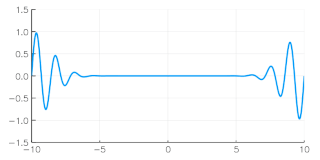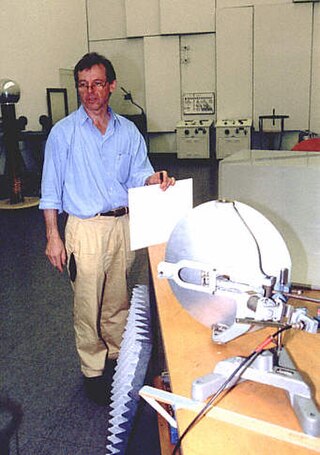Related Research Articles
Faster-than-light travel and communication are the conjectural propagation of matter or information faster than the speed of light. The special theory of relativity implies that only particles with zero rest mass may travel at the speed of light, and that nothing may travel faster.

The group velocity of a wave is the velocity with which the overall envelope shape of the wave's amplitudes—known as the modulation or envelope of the wave—propagates through space.

The speed of light in vacuum, commonly denoted c, is a universal physical constant that is exactly equal to 299,792,458 metres per second. According to the special theory of relativity, c is the upper limit for the speed at which conventional matter or energy can travel through space.

Ionization is the process by which an atom or a molecule acquires a negative or positive charge by gaining or losing electrons, often in conjunction with other chemical changes. The resulting electrically charged atom or molecule is called an ion. Ionization can result from the loss of an electron after collisions with subatomic particles, collisions with other atoms, molecules and ions, or through the interaction with electromagnetic radiation. Heterolytic bond cleavage and heterolytic substitution reactions can result in the formation of ion pairs. Ionization can occur through radioactive decay by the internal conversion process, in which an excited nucleus transfers its energy to one of the inner-shell electrons causing it to be ejected.
Matter waves are a central part of the theory of quantum mechanics, being half of wave–particle duality. At all scales where measurements have been practical, matter exhibits wave-like behavior. For example, a beam of electrons can be diffracted just like a beam of light or a water wave.
In physics, coherence expresses the potential for two waves to interfere. Two monochromatic beams from a single source always interfere. Physical sources are not strictly monochromatic: they may be partly coherent. Beams from different sources are mutually incoherent.
In physics, quantum tunnelling, barrier penetration, or simply tunnelling is a quantum mechanical phenomenon in which an object such as an electron or atom passes through a potential energy barrier that, according to classical mechanics, should not be passable due to the object not having sufficient energy to pass or surmount the barrier.

The quantum Zeno effect is a feature of quantum-mechanical systems allowing a particle's time evolution to be slowed down by measuring it frequently enough with respect to some chosen measurement setting.

A metamaterial is any material engineered to have a property that is rarely observed in naturally occurring materials. They are made from assemblies of multiple elements fashioned from composite materials such as metals and plastics. These materials are usually arranged in repeating patterns, at scales that are smaller than the wavelengths of the phenomena they influence. Metamaterials derive their properties not from the properties of the base materials, but from their newly designed structures. Their precise shape, geometry, size, orientation and arrangement gives them their smart properties capable of manipulating electromagnetic waves: by blocking, absorbing, enhancing, or bending waves, to achieve benefits that go beyond what is possible with conventional materials.

Electromagnetically induced transparency (EIT) is a coherent optical nonlinearity which renders a medium transparent within a narrow spectral range around an absorption line. Extreme dispersion is also created within this transparency "window" which leads to "slow light", described below. It is in essence a quantum interference effect that permits the propagation of light through an otherwise opaque atomic medium.
Stochastic electrodynamics (SED) is extends classical electrodynamics (CED) of theoretical physics by adding the hypothesis of a classical Lorentz invariant radiation field having statistical properties similar to that of the electromagnetic zero-point field (ZPF) of quantum electrodynamics (QED).

An optical parametric oscillator (OPO) is a parametric oscillator that oscillates at optical frequencies. It converts an input laser wave with frequency into two output waves of lower frequency by means of second-order nonlinear optical interaction. The sum of the output waves' frequencies is equal to the input wave frequency: . For historical reasons, the two output waves are called "signal" and "idler", where the output wave with higher frequency is the "signal". A special case is the degenerate OPO, when the output frequency is one-half the pump frequency, , which can result in half-harmonic generation when signal and idler have the same polarization.
Slow light is the propagation of an optical pulse or other modulation of an optical carrier at a very low group velocity. Slow light occurs when a propagating pulse is substantially slowed by the interaction with the medium in which the propagation takes place.

Günter Nimtz is a German physicist, working at the 2nd Physics Institute at the University of Cologne in Germany. He has investigated narrow-gap semiconductors and liquid crystals. His claims show that particles may travel faster than the speed of light when undergoing quantum tunneling.

Robert William Boyd is an American physicist noted for his work in optical physics and especially in nonlinear optics. He is currently the Canada Excellence Research Chair Laureate in Quantum Nonlinear Optics based at the University of Ottawa, professor of physics cross-appointed to the school of electrical engineering and computer science at the University of Ottawa, and professor of optics and professor of physics at the University of Rochester.

Modern searches for Lorentz violation are scientific studies that look for deviations from Lorentz invariance or symmetry, a set of fundamental frameworks that underpin modern science and fundamental physics in particular. These studies try to determine whether violations or exceptions might exist for well-known physical laws such as special relativity and CPT symmetry, as predicted by some variations of quantum gravity, string theory, and some alternatives to general relativity.

Harry Friedmann was a professor of chemistry who specialized in theoretical nonlinear optics and lasers in biology.

Carlos Ray Stroud, Jr. is an American physicist and educator. Working in the field of quantum optics, Stroud has carried out theoretical and experimental studies in most areas of the field from its beginnings in the late 1960s, studying the fundamentals of the quantum mechanics of atoms and light and their interaction. He has authored over 140 peer-reviewed papers and edited seven books. He is a fellow of the American Physical Society and the Optical Society of America, as well as a Distinguished Traveling Lecturer of the Division of Laser Science of the American Physical Society. In this latter position he travels to smaller colleges giving colloquia and public lectures.
Photonic topological insulators are artificial electromagnetic materials that support topologically non-trivial, unidirectional states of light. Photonic topological phases are classical electromagnetic wave analogues of electronic topological phases studied in condensed matter physics. Similar to their electronic counterparts, they, can provide robust unidirectional channels for light propagation.

Herbert Graves Winful is a Ghanaian-American engineering professor, whose honours include in 2020 the Quantum Electronics Award. He is the Joseph E. and Anne P. Rowe Professor of Electrical Engineering, Arthur F. Thurnau Professor of Electrical Engineering and Computer Science, and a Professor of Physics at the University of Michigan.
References
- 1 2 T. E. Hartman (1962). "Tunneling of a wave packet". Journal of Applied Physics . 33 (12): 3427. Bibcode:1962JAP....33.3427H. doi:10.1063/1.1702424.
- ↑ J. J. Hupert and G. Ott (1966). "Electromagnetic analog of the quantum-mechanical tunnel effect". American Journal of Physics . 34 (3): 3427. Bibcode:1966AmJPh..34..260H. doi:10.1119/1.1972898.
- ↑ E. H. Hauge and J. A. Stovneng (1989). "Tunneling times: a critical review". Reviews of Modern Physics . 61 (4): 917. Bibcode:1989RvMP...61..917H. doi:10.1103/RevModPhys.61.917.
- ↑ H. Winful (2006). "Tunneling time, the Hartman effect, and superluminality: A proposed resolution of an old paradox" (PDF). Physics Reports . 436 (1–2): 1–69. Bibcode:2006PhR...436....1W. doi:10.1016/j.physrep.2006.09.002.
- 1 2 Gavassino, L.; Disconzi, M. M. (2023-03-13). "Subluminality of relativistic quantum tunneling". Physical Review A. 107 (3): 032209. doi:10.1103/PhysRevA.107.032209.
- ↑ A. Enders and G. Nimtz (1992). "On superluminal barrier traversal". Journal de Physique I . 2 (9): 1693–1698. Bibcode:1992JPhy1...2.1693E. doi:10.1051/jp1:1992236.
- ↑ A. Enders and G. Nimtz (1993). "Evanescent-mode propagation and quantum tunneling". Physical Review E . 48 (1): 632–634. Bibcode:1993PhRvE..48..632E. doi:10.1103/PhysRevE.48.632. PMID 9960633.
- ↑ C. Spielmann, R. Szipocs, A. Stingl, F. Krausz (1994). "Tunneling of optical pulses through photonic band-gaps". Physical Review Letters . 73 (17): 2308–2311. Bibcode:1994PhRvL..73.2308S. doi:10.1103/PhysRevLett.73.2308. PMID 10057027.
{{cite journal}}: CS1 maint: multiple names: authors list (link) - ↑ S. Longhi, M. Marano, P. Laporta, M. Belmonte (2001). "Superluminal optical pulse propagation at 1.5 μm in periodic fiber Bragg gratings". Physical Review E . 64 (5): 055602. doi:10.1103/PhysRevE.64.055602. PMID 11736006.
{{cite journal}}: CS1 maint: multiple names: authors list (link) - ↑ P. Balcou and L. Dutriaux (1997). "Dual optical tunneling times in frustrated total internal reflection". Physical Review Letters . 78 (5): 851–854. Bibcode:1997PhRvL..78..851B. doi:10.1103/PhysRevLett.78.851.
- ↑ S. Yang, J. Page, Z. Liu, M. Cowan, C. Chan, P. Sheng (2002). "Ultrasound tunneling through 3D phononic crystals". Physical Review Letters . 88 (10): 104301. Bibcode:2002PhRvL..88j4301Y. doi:10.1103/PhysRevLett.88.104301. PMID 11909358.
{{cite journal}}: CS1 maint: multiple names: authors list (link) - ↑ W. Robertson, J. Ash, J. McGaugh (2002). "Breaking the sound barrier: Tunneling of acoustic waves through the forbidden transmission region of a one-dimensional acoustic band gap array". American Journal of Physics . 70 (7): 689. Bibcode:2002AmJPh..70..689R. doi:10.1119/1.1477430.
{{cite journal}}: CS1 maint: multiple names: authors list (link) - ↑ H. Winful (2002). "Energy storage in superluminal barrier tunneling: origin of the "Hartman Effect"". Optics Express . 10 (25): 1491–1496. Bibcode:2002OExpr..10.1491W. doi: 10.1364/OE.10.001491 . PMID 19461683.
- ↑ H. Winful (2003). "The meaning of group delay in barrier tunneling: a re-examination of superluminal group velocities". New Journal of Physics . 8 (6): 101. arXiv: quant-ph/0601085 . doi: 10.1088/1367-2630/8/6/101 .
- ↑ H. Winful (2006). "Tunneling time, the Hartman effect, and superluminality: A proposed resolution of an old paradox" (PDF). Physics Reports . 436 (1–2): 1–69. Bibcode:2006PhR...436....1W. doi:10.1016/j.physrep.2006.09.002.
- ↑ H. Winful (2003). "Delay time and the Hartman effect in quantum tunneling". Physical Review Letters . 91 (26): 26041. Bibcode:2003PhRvL..91z0401W. doi:10.1103/PhysRevLett.91.260401. PMID 14754030.